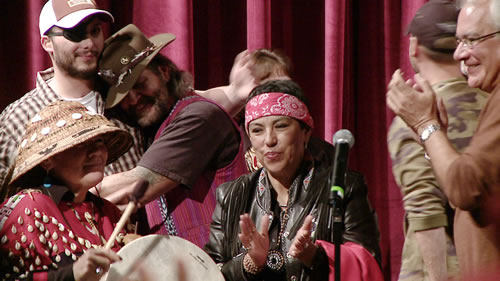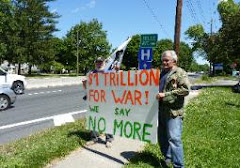| Book project supported by VFP 21 |
By Jan Barry
Across America, a special gift is arriving at numerous homes this week. This gift is a new book by Warrior Writers titled After Action Review: A Collection of Writing and Artwork by Veterans of the Global War on Terror.
What makes this book decidedly different from so many other gifts this holiday season is three-fold: its handcrafted artistry by young men and women who turned sleepless nights and troubled days into making art with hands that for too long held war weapons; its funding by dozens of supporters who collectively chipped in thousands of dollars to pay for the printing and postage; and its timing—published just as the war in Iraq was officially declared over and the last US military units departed that war-savaged land.
Here at home, a great many veterans of deployments in Iraq and Afghanistan are trying to turn off unrelenting war memories. Some try chasing off nightmares with hard drinking, drugs, death-defying lifestyles. Some find nothing seems to work. As Zach LaPorte, a former Army Ranger who served twice in Iraq, writes in a poem titled “Spliced”:
My life is like a slide show, spliced with images of the desert.
Mom asks me if I like the potatoes,
A woman shrieks from a bloodied mouth.
My Professor hands me an exam paper,
I’m riding in the door of a Blackhawk.
I walk alone at night past neon signs,
Crimson tracers snap so close you could touch.
I sit in my air-conditioned cubicle,
The blood in my brain boils.
The scars run deeper than they appear.
LaPorte’s poem is a troubling, yet heartening example of what the Warriors Writers project and this anthology are about: writing war images and injuries out, releasing them to the light of day, shared with those who care, aired to help heal hidden torments that long ago were called “soldier’s heart.”
"It's hard to overestimate how writing can heal long scarred over wounds that every veteran inevitably has,” Josiah White, a former Marine who was wounded by a suicide bomber, writes in a quote displayed on the back cover. “These stories and poems also have the power of communicating a near impossible message to non-veterans, those hurt by war, those hurt by tragedy, anyone who has ever suffered and asked the question ‘why?’ No one will read this book and come away unchanged."
With the 10-year war in Afghanistan still raging and flailing dangerously into Pakistan, this book raises veterans’ concerns that extend far beyond the mission in Iraq that just ended. In the Foreword, Brian Turner—author of one of the first poetry books to come out of the war in Iraq, Here, Bullet—writes that the works in this anthology “seem to suggest that we would be wise to take stock of where we are now, as a country.”
Many of the pieces in this collection by more than 60 contributors focus on an incident that triggered disconcerting change in perspective in the midst of military life. In a poem titled “Happy Birthday,” Zachariah Dean writes about suddenly realizing he just turned 26 as death whizzes by in the middle of a firefight in Afghanistan in which his rifle is jammed by a defective bullet. Scrambling to fix the rifle, it hits him how carelessly he’s led his life to end up in such a desperate jam. "I wrote this in a hurry in a machine gun turret several nights later,” he notes in the poem, stunned by the surreal experience. “Try to burn it out of memory by putting it on paper…"
Others focus on trying to find a thread that may bring deeply sought change for the better in a veteran’s life. In a sardonic welcome home for himself and other veterans, Garett Reppenhagen wrote in a poem titled “Black Out Drive”:
“Heeeey, welcome home brother.”
Just grip that wheel hero.
Stay alert, stay alive.
The real war has just started,
Your fight to survive.
Jacob George, who served three tours in Afghanistan with the Army, reaches out to fellow Americans in a poem titled “Support the Troops”:
don’t thank me for what I’ve done
give me a big hug
and let me know
we’re not going to let this happen again
because we support the troops
and we’re gonna bring these wars to an end
Unlike collections of writings by warriors of previous wars, women veterans take a prominent role in this anthology. Air Force veteran Kristina Vogt captures the bizarre military bureaucratic mumbo-jumbo that she describes as, from a female perspective, creating “the womb of the WoMD” (weapons of mass destruction)—the official reason for invading Iraq, which became as illusive as a desert mirage.
“I am the savage,” writes Emily Yates, who served two combat tours in Iraq, describing bursting into “proud homes” looking for elusive enemies, where women and children “stand in the doorway with fearful faces,” while she the armed American soldier wields “the weapon of ignorance … the shield of arrogance,” speaking with “the voice of entitlement….”
Former Army sergeant Robynn Murray, in a poem titled “Eviscerated,” throws the disillusionment of serving in terrorizing raids on Iraqi civilians directly at war supporters back home:
I am your walking wounded broken toy soldier,
and your flag is burning and all your yellow ribbons have fallen down.
I cut open these festers to force your eyes to see the truth so damn it, LOOK!
Look at what has become of me, of us.
I will gladly reopen these wounds if there is change that will come of it.
So that no one else receives these scars. …
Woven throughout the poetry and essays in this collection is an arresting gallery of often startling artwork. These include an American flag made of bullet casings (“Bullet Flag” by Lars Ekstrom); a toy soldier inside a prescription bottle (“Trapped” by Malachi Muncy); and a drawing of a walking skeleton with flaming oil derricks crowning the skull (“Greed Walks” by Eric Estenzo).
Many of the works in this book address post-traumatic stress disorder (PTSD). Chantelle Bateman, a Marine veteran of Iraq, writes about “anger is the color I sometimes paint the town with … louder than incoming and the sirens they play when I hit the deck … I’m just a pile of tears needing to punch you”. Another former Marine, Jon Turner, punches at everything in sight in Iraq and back home in a string of explosive, insightful, drunken, cold sober images of human encounters, rejections, attempts at reaching out that ends with these lines:
In the unwritten letters and poems—
are the hidden faces of war
Several pieces reach breathtakingly out of inner turmoil to find an uplifting path. “I desire to trust life,” writes former Marine Liam Madden, “to cultivate my unique and needed gifts/Loving with abandon/ I intend to weave a web of gratitude into my community.” His poem “Intention” is the first in the book, followed by a wide array of perspectives drawn from a decade of war. The last poem is called “Brio,” in which Army veteran Maggie Martin, who served twice in Iraq, joins others in various civic actions:
I sow community in re-acquisitioned places,
Crowded city street, marching orders, protest song,
Our hands and mouths’ unsinkable strength.
…
Old constructs crumble and blow away,
new consciousness takes root.
The concluding section showcases photos of veterans at Warrior Writers workshops in cities around the country, accompanied by a quote by Eli Wright, a former Army combat medic: "I used to write before I went to Iraq, but when I got over there, I wasn't able to write. So through Warrior Writers I have been able to slowly begin to find my words again and share my experiences and what happened over there. It's been a healing experience."
The nearly 200-page anthology was compiled and edited by Lovella Calica, the director of Warrior Writers, which is based in Philadelphia, PA, with the assistance of a number of contributors and supporters. I aided the project as an advisor and copy editor. The book was artfully designed by Rachel McNeill, an Army veteran who included thought-provoking photos shot on patrols in Iraq by herself and others. A series of drawings and paintings titled “Dust Works” by Army National Guard veteran Aaron Hughes provides a visual theme of roads through war on the cover and throughout the book.
After Action Review (paperback, $20) is the third in a series of anthologies of writing and art by Iraq and Afghanistan veterans published by Warrior Writers, and is available at www.warriorwriters.org.
VFP Chapter 21 contributed to the financial support for this book project.
















